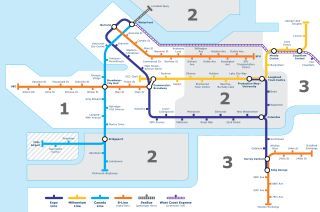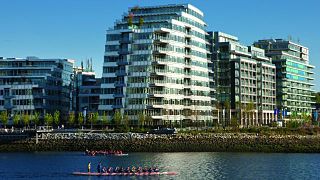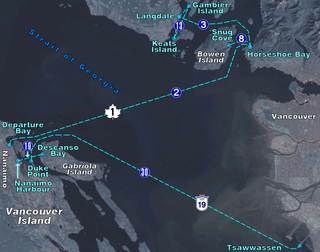A ferry is a watercraft that carries passengers, and sometimes vehicles and cargo, across a body of water. A small passenger ferry with many stops, such as in Venice, Italy, is sometimes called a water taxi or water bus.

Granville Island is a peninsula and shopping district in the Fairview neighbourhood of Vancouver, British Columbia, Canada, across False Creek from Downtown Vancouver, under the south end of the Granville Street Bridge. Formerly an industrial manufacturing area, it was named after Granville Leveson-Gower, 2nd Earl Granville.

Waterfront station is a major intermodal public transportation facility and the main transit terminus in Vancouver, British Columbia, Canada. It is on West Cordova Street in Downtown Vancouver, between Granville and Seymour Street. The station is also accessible via two other street-level entrances, one on Howe Street to the west for direct access to the Expo Line and another on Granville Street to the south for direct access to the Canada Line.

A water taxi or a water bus is a watercraft used to provide public or private transport, usually, but not always, in an urban environment. Service may be scheduled with multiple stops, operating in a similar manner to a bus, or on demand to many locations, operating in a similar manner to a taxi. A boat service shuttling between two points would normally be described as a ferry rather than a water bus or taxi.

False Creek is a short narrow inlet in the heart of Vancouver, separating the Downtown and West End neighbourhoods from the rest of the city. It is one of the four main bodies of water bordering Vancouver, along with English Bay, Burrard Inlet, and the Fraser River. Granville Island is located within the inlet.

Yaletown is an area of Downtown Vancouver, Canada, bordered by False Creek and Robson and Homer Streets. Formerly a heavy industrial area dominated by warehouses and rail yards, since the 1986 World's Fair it has been transformed into one of the most densely populated neighbourhoods in the city.

Main Street–Science World is an elevated station on the Expo Line of Metro Vancouver's SkyTrain rapid transit system in Vancouver, British Columbia, Canada. The station is accessible from both sides of Main Street at the intersection of Main Street and Terminal Avenue and is adjacent to Pacific Central Station, the city's inter-city railway and bus terminal.

The K-class ferries are a group of similarly designed ferries operated by both BC Ferries and TransLink in British Columbia, Canada.

The Vancouver Downtown Historic Railway was a heritage electric railway line that operated from 1998 to 2011 between Granville Island and Science World, in Vancouver, British Columbia, Canada. It operated only on weekends and holidays, usually from May to mid-October, and was aimed primarily at tourists. Two restored interurban trams were used on the line, which used a former freight railway right-of-way.

The 98 B-Line was a bus rapid transit line in Metro Vancouver, British Columbia, Canada, that began service in September 2000. It linked Richmond to Downtown Vancouver, with a connection to Vancouver International Airport. It travelled mainly along Granville Street in Vancouver and a dedicated bus lane on No. 3 Road in Richmond. It was operated by Coast Mountain Bus Company and was funded by TransLink. The route was 16 kilometres (9.9 mi) long. The line carried over 18,000 passengers daily. It was discontinued in September 2009, shortly after the opening of the Canada Line, which replaced it.

Downtown Vancouver is the central business district and the city centre neighbourhood of Vancouver, Canada, on the northwestern shore of the Burrard Peninsula in the Lower Mainland region of British Columbia. It occupies most of the north shore of the False Creek inlet, which cuts into the Burrard Peninsula creating the Downtown Peninsula, where the West End neighbourhood and Stanley Park are also located.

Transportation in Vancouver, British Columbia, has many of the features of modern cities worldwide. Unlike many large metropolises, Vancouver has no freeways into or through the downtown area. A proposed freeway through the downtown was rejected in the 1960s by a coalition of citizens, community leaders and planners. This event "signalled the emergence of a new concept of the urban landscape" and has been a consistent element of the city's planning ever since.

Olympic Village is an underground station on the Canada Line of Metro Vancouver's SkyTrain rapid transit system. The station is located at the intersection of Cambie Street and West 2nd Avenue, adjacent to the Cambie Street Bridge in Vancouver, British Columbia, Canada.
Allied Shipbuilders Ltd is a privately held shipbuilding and ship repairing company established in Canada in 1948.

False Creek Ferries, a division of Granville Island Ferries Ltd, is a privately owned and operated ferry service that operates on False Creek near downtown Vancouver, British Columbia, Canada. The False Creek Ferry fleet has grown from the four electric ferries that formed the company to a fleet that now consists of 17 ferries divided into three classes; the 20-passenger Balfry class, the 12-passenger Spirit class, and the open-deck Novel class. The service operates every day of the year, except Christmas Day and Boxing Day.

The Vancouver Olympic Village (VVL) is a neighbourhood and Olympic Village built by Millennium Development Group in Vancouver, British Columbia, Canada, originally built for the 2010 Winter Olympics and 2010 Winter Paralympics.
Granville Island Water Taxi Services was a privately owned and operated water taxi service in the Lower Mainland, British Columbia, Canada, which was replaced by English Bay Launch in the Fall of 2009. It was one of three water taxi services connecting Bowen Island to Vancouver with regularly scheduled service. It also offered on demand charter services around the greater Vancouver area.
English Bay Launch is a privately owned and operated water taxi service in the Lower Mainland, British Columbia, Canada, which replaced Granville Island Water Taxi Services in the Fall of 2009. It is one of three water taxi services connecting Bowen Island to Vancouver with regularly scheduled service. It also offers on demand charter services around the greater Vancouver area. It operates an enclosed 27-foot Eagle Craft vessel named The Eagle 14. Passengers are allowed to bring bicycles on board.

The Bowen Island ferry travels between Snug Cove on Bowen Island, and Horseshoe Bay in the District of West Vancouver, British Columbia, Canada, a trip of three nautical miles across Queen Charlotte Channel. A scheduled ferry has been in operation since 1921, when Bowen Island was a popular holiday destination. Prior to that year, transportation to the island was by steamship from Vancouver, with only one trip daily. The Bowen Island ferry used a fleet of small passenger vessels until 1956, when a single car ferry began passenger service, and that ferry began carrying vehicles in 1958. In 2022 the route carried in excess of 1.2 million passengers plus 570,000 vehicles.

The architecture of Vancouver and the Greater Vancouver area consists of a variety of modern architectural styles, such as the 20th-century Edwardian and the 21st-century modernist styles. Initially, the city architects embraced styles developed in Europe and the United States, with only limited local variation.

















